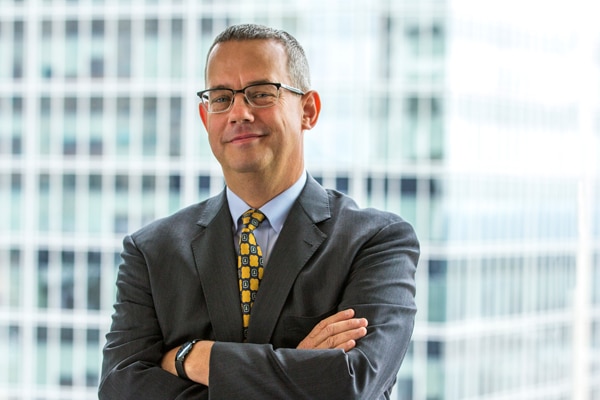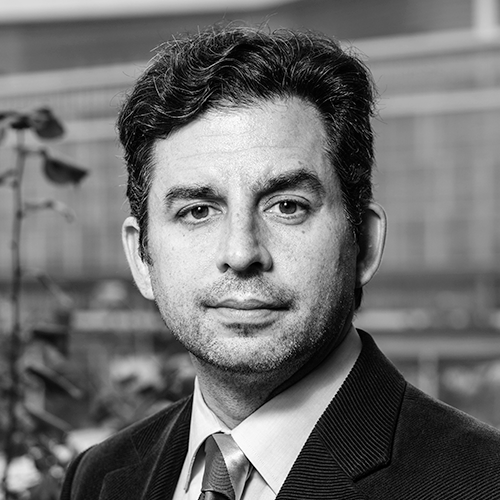
Michael Cunningham compares Red Hat’s explosive growth to a snowball—barreling down a hill gaining speed, size, weight, and momentum.
Cunningham, Red Hat’s executive vice president and general counsel, says it’s up to the software company’s staff and leadership team to prepare a path for the snowball’s growth to continue. Otherwise, he says, Red Hat risks being crushed by its own growth.
As general counsel, Cunningham spends a significant portion of time and effort planning for the future, something he says is crucial to thriving in such a fast-paced company. Since he joined in 2004, Red Hat has grown from about 650 employees and $125 million in annual revenue to roughly 9,300 employees and more than $2 billion in revenue. The Raleigh, North Carolina-based company is the world’s largest provider of open-source solutions, with a client base that includes most Fortune 500 companies, investment banks, stock exchanges, and even the White House.
“The growth is so continuous and pervasive, in some sense it means we don’t have the luxury of optimizing the present,” he says. “We need to spend a ton of time preparing for the future.”
Cunningham takes a proactive approach to all aspects of his job, from hiring new employees and outside counsel to getting involved in industry groups. Here, Cunningham shares with Modern Counsel his top six tips for managing rapid growth.
1. Hire for the future
When Cunningham hires someone for his legal team of roughly sixty people, he looks for candidates who are capable of contributing to a company, particularly in the long term. He hires people with the capacity to innovate at a $5 billion company—a goal he hopes Red Hat will achieve in relatively short order.
That’s not to say that candidates must only be motivated. He often favors applicants that have deep experience in one or more areas of the technology industry. Cunningham strives to make strategic hires that fulfill a specific need tied to growth, such as reinforcing privacy as the company gets involved in more customer data, handling increased mergers and acquisitions, or dealing with open-source licensing.
“We end up being very picky about the people we hire,” he says. “We envision them as performers today and also needing the capabilities of being in a much larger organization.”
2. Make sure applicants are the right fit
Red Hat is a mission-driven company, so it’s important that employees are passionate and mesh with the culture. Cunningham often meets job candidates twice, and whenever possible, he or his colleagues share a meal with the candidates to get to know them in a different environment.
Cunningham believes hiring panels should include staff members of varied genders, cultural backgrounds, personalities, and other attributes.
“This allows the panel to see how an applicant would survive or thrive in a diverse company,” Cunningham says. In addition, it helps decision makers overcome unconscious bias and gain multiple perspectives on how an applicant might fit into Red Hat’s fast-paced, rough-and-tumble culture.
The people who work for Red Hat, Cunningham says, believe in doing something beyond merely earning a paycheck. Employees that work for the company—and anyone who intends to join—believe in making better software faster, spurring new businesses in open-source, and liberating innovation more quickly.
“Finding people that are passionate and good cultural fits and identify with the company is very important because at those growth rates, this isn’t a place for the faint of heart,” he says.
3. Seek deeper relationships with outside counsel
Sustaining rapid, successful growth requires contributions from everyone, including outside counsel. Cunningham says he uses surprisingly little outside counsel, but he does seek deeper relationships with the attorneys he hires for core business needs. By working with a relatively few number of firms that understand open-source and Red Hat’s vision for the future, these alliances can provide context to their legal advice
Of course, special cases come up where Red Hat may need outside help on matters such as local zoning issues. Still, if the case is closely tied to the heart of the business, Cunningham doesn’t like to throw it at people who don’t understand Red Hat.
“We learned a long time ago that understanding the right answer in the law is a relatively smaller part of lawyering,” he says, adding that it’s just as important to be able to explain it and get others to appreciate and embrace it.
4. Emphasize excellence and continuous improvement
Red Hat places high value on not just growing larger, but advancing quality.
“If you touch it, make it better. If you are going to come up with a process for the future, build in the idea that it may need to be able to continuously improve.”
The company promotes continued development by providing different experiences, training, and mentoring to ensure employees grow personally and professionally along with the scale of the business.
5. Don’t forget the big picture
As a provider of open-source software developed with public collaboration, intellectual property is especially important to Red Hat. Cunningham and Red Hat have also invested in promising open-source start-ups. Red Hat has sought reforms to patent and copyright laws and has helped champion and participate in a number of novel IP solutions.
“We try to prepare for the future by taking a broad view of making it a robust ecosystem for open-source,” he says.
On an individual level, Cunningham is also working to make sure the industry as a whole is ready for the future. He’s a board member for the LOT Network, a group of major companies that work to reduce the economic drag on innovation caused by patent trolls. He’s also board chairman for the Open Invention Network, which provides a royalty-free patent commons for Linux-related technologies.
Neither of these organizations helped the business right off the bat, Cunningham says. Both are more focused on making the world a stronger, safer place to liberate the innovation of open-source software.
“It’s been fun to think that far in the future,” he says.
6. Set aside time for planning and stay well-connected
It’s a constant struggle to balance the daily grind with being proactive and thinking ahead, but Cunningham says he cordons off specific time to plan for the future and rewards employees for doing the same. Even if he has a pressing problem on his plate, he says he’ll stop to chat with a colleague who wants to discuss ideas for improving the company and moving it forward. The company has an ethos of being competitive on excellence but also making employees feel comfortable seeking help and input.
As a trusted confidante to the CEO and adviser to the board, Cunningham is among several senior executives who help set the company’s broader strategies, directions, and priorities. He makes sure his legal team stays up-to-date on these objectives so they can anticipate issues that might arise in the future.
“It doesn’t do any good for me to go, ‘Oh my gosh, we’ve got a lot to do to get ready to be a $5 billion company that’ll have five more product lines,’” he says. “I need them to feel it viscerally as well.”
With these strategies—hiring forward-thinking people, supporting the broader industry through collaborative efforts, and prioritizing continuous improvements and readiness preparation—Cunningham and his team have not only been able to keep from getting crushed by the snowball; they’ve been able propel it forward.

